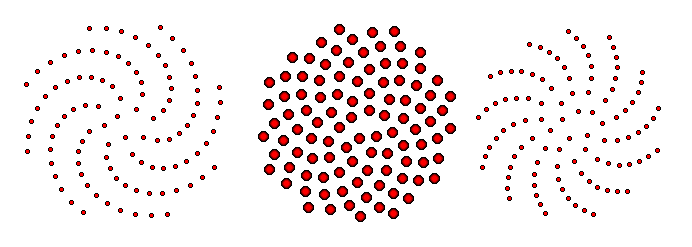Fermat's spiral

Fermat's spiral (also known as a parabolic spiral) was first discovered by Pierre de Fermat,[1] and follows the equation
in polar coordinates (the more general Fermat's spiral follows ).
It is a type of Archimedean spiral.[2]
As a parametric equation
As a parametric equation, the formula is [2][3]
Here, sgn(a) denotes the sign function of a. By parametric equation implicitization, this isn't so difficult, as can be turned into . And,
So, .
The Golden Ratio and the Golden Angle
In disc phyllotaxis, as in the sunflower and daisy, the mesh of spirals occurs in Fibonacci numbers because divergence (angle of succession in a single spiral arrangement) approaches the golden ratio. The shape of the spirals depends on the growth of the elements generated sequentially. In mature-disc phyllotaxis, when all the elements are the same size, the shape of the spirals is that of Fermat spirals—ideally. That is because Fermat's spiral traverses equal annuli in equal turns. The full model proposed by H Vogel in 1979[4] is
where θ is the angle, r is the radius or distance from the center, and n is the index number of the floret and c is a constant scaling factor. The angle 137.508° is the golden angle which is approximated by ratios of Fibonacci numbers.[5]
Solar plants
Fermat's spiral has also been found to be an efficient layout for the mirrors of concentrated solar power plants.[6]
See also
References
- ↑ "Pierre de Fermat". Retrieved 2017-07-09.
- 1 2 "Fermat's Spiral". Fermat's Spiral. Wolfram Mathworld. Retrieved 15 July 2017.
- ↑ "Fermat's Spiral". Geometry Atlas. Saltire Software. 2017. Retrieved 2017-07-09.
- ↑ Vogel, H (1979). "A better way to construct the sunflower head". Mathematical Biosciences. 44 (44): 179–189. doi:10.1016/0025-5564(79)90080-4.
- ↑ Prusinkiewicz, Przemyslaw; Lindenmayer, Aristid (1990). The Algorithmic Beauty of Plants. Springer-Verlag. pp. 101&ndash, 107. ISBN 978-0-387-97297-8.
- ↑ Noone, Corey J.; Torrilhon, Manuel; Mitsos, Alexander (December 2011). "Heliostat Field Optimization: A New Computationally Efficient Model and Biomimetic Layout". Solar Energy. doi:10.1016/j.solener.2011.12.007.
Further reading
- J. Dennis Lawrence (1972). A catalog of special plane curves. Dover Publications. pp. 31, 186. ISBN 0-486-60288-5.
External links
- Hazewinkel, Michiel, ed. (2001) [1994], "Fermat spiral", Encyclopedia of Mathematics, Springer Science+Business Media B.V. / Kluwer Academic Publishers, ISBN 978-1-55608-010-4
- Online exploration using JSXGraph (JavaScript)
- Fermat's Natural Spirals, in sciencenews.org

